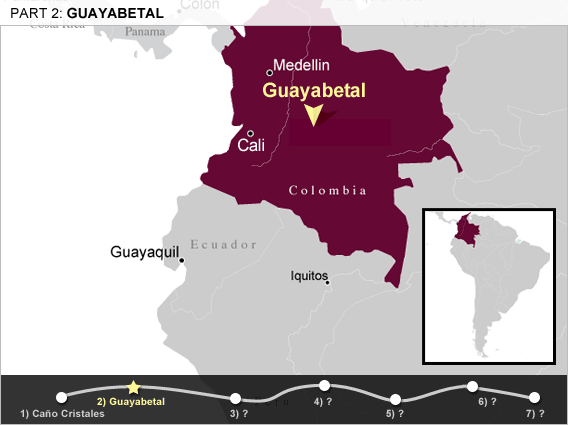A Death-Defying Commute
The second hidden wonder of South America.
GUAYABETAL, Colombia—On his monumental four-year trek through Peru between 1838 and 1842, Swiss naturalist and explorer Johann Jakob von Tschudi passed through a "miserable little Indian village called Saco" high in the central Andes. There, he encountered "a curious kind of bridge" called a huaro, which consisted of just a single thick rope strung between two walls of a steep chasm. "To this rope are affixed a roller and a strong piece of wood formed like a yoke," Tschudi wrote in his travelogue. Travelers wishing to cross the canyon affixed themselves to the roller and, with another rope tied around their waist, they were pulled from one end to the other. "This is altogether the most disagreeable and dangerous mode of conveyance that can possibly be conceived. If the rope breaks, an accident of no unfrequent occurrence, the hapless traveller has no chance of escaping with life." Another 19th-century writer described crossing a huaro as "a gymnastic feat of no easy accomplishment."
I'd read that in a few isolated valleys of the Andes, where the spans are too long, too deep, and crossed by too few people for a bridge to be worth building, you can still find villages where the only way in or out is by rope. One such spot happened to be on our route back to Bogotá from the Caño Cristales in the steeply walled Rio Negro Valley, near a small town called Guayabetal.

With the help of a driver we hired in Villavicencio, Dylan and I spent an afternoon driving up and down the Rio Negro valley asking locals where we could find the last of these proto-ziplines still in use. We pulled off the road in front of a small brick house to ask directions, and just as we were getting out of the car, I spotted a middle-aged man with a machete hanging from his waist disappear with a dog down a slope into the valley below. We followed him to a six-foot-tall concrete pylon, which anchored a steel cable that spanned the 1,200-foot-deep ravine and disappeared into the trees on the opposite side, a quarter of a mile away. Without acknowledging us, the man wrapped a length of rope around his waist, and then wrapped another rope under the front legs of his surprisingly calm dog. He squeezed the dog tightly between his thighs, hooked his rope saddle onto a small metal roller that rested atop the cable, and balanced a wooden yoke—just like the one Tschudi described—on top of the line. We watched the man casually throw himself and his dog off the edge of the gorge, and grow smaller and smaller as they accelerated to a speed that I'd read has been clocked at nearly 60 miles per hour.
Back up the hill, the woman who owned the home in whose backyard we were standing came out the front door and introduced herself as Ney Riaño. She explained that the cable had been put up by loggers about 60 years ago and was maintained by the local community. On an average day, it is used by about 15 people, mostly farmers going back and forth to fields on the other side of the valley, in what must be the world's most harrowing daily commute. The half-minute ride spares them a hike of two to four hours up and down a steep path through the forest.
Riaño said she didn't know when the man with the dog would be making his return trip, via a second cable rooted another 100 meters up the wall of the valley, but she offered to call a pair of young farmers who use the line regularly. Twenty minutes later, 21-year-old Hector Juavita and 17-year-old Mario Romero came marching down the highway from the direction of Guayabetal. They had gobs of gel in their hair, and they were dressed in what seemed to be their Sunday finest. Each had a length of rope draped over his shoulder and both were holding a simple wooden yoke that appeared to have been cut from the fork in a tree. Though the cable is a public utility, anyone who wants to use it has to bring his own equipment.
Hector, who used to live on the other side of the valley, demonstrated how, with a couple of basic knots, he was able to construct a saddle out of the rope. To me it looked more like a simple loop than anything you might call a harness, but Hector assured us that so long as he didn't shift his weight around too much and he kept the rope tight under his rear end, there was little chance of falling out.
"Your rope appears to be a little frayed," I pointed out, warily. But Mario, who has been going back and forth on the cable since he was 8 years old, said that he was so confident in his harness, he would happily take one of us across with him. I laughed at the idea. Dylan, in a momentary lapse of judgment, forgot that his fiancee and mother might someday read this and eagerly volunteered.
Press reports differ as to how many locals have fallen from the Rio Negro valley's makeshift cables. One story claimed that 22 people have plunged to their deaths over the years. Mario and Hector told us they thought the number of victims was more like three. The most recent fatality occurred in 2004, when a 34-year-old man named Alvaro Rey was decapitated while trying to cross with two other passengers lashed to him (they both survived). He'd already used the cable earlier that day to pass two beds, a dog house, chickens, a television, a stereo, and three chairs across the valley without a hitch.
In the late 1990s, a Bogotá TV news program did an exposé on the cables. The piece included a clip of a 6-year-old boy who lived on the far side of the valley zipping across the line to get to school. A public outcry ensued, provoking calls from Bogotá for the cables to be torn down. The lines were technically illegal, but because the Rio Negro Valley spans two Colombian states—Meta and Cundinamarca—it had never been clear who had jurisdiction over them. In 2001, the government finally ordered 18 of the cables removed.
Locals saw the move not only as a threat to their livelihoods but as disrespectful of an old tradition that had served the community for generations. The mayor of Guayabetal reportedly received death threats saying that if he complied with orders to remove the cables, he'd be "carried out in wooden pajamas"—an old Spanish euphemism for a coffin. In an op-ed published in Colombia's largest newspaper, El Tiempo,a man who'd used one of the cables for 20 years without incident wrote, "If the authorities are so concerned with safety, they should take away airplanes, since not long ago one crashed in the United States, killing all 260 passengers." To protest the impending removal, a local woman slid out to the middle of one of the lines and dangled there for hours.
In the end, all but four of the cables were removed. And a school was built on the far side of the valley so that children no longer have to zip back and forth each day. Instead, a teacher from Guayabetal now crosses over at the beginning of the week and comes back to town for the weekend.
For Mario and Hector, however, the cable commute remains a daily fixture. "So long as it's not windy or rainy, it's not usually a problem," said Mario, who had taken off his shirt to keep it from getting dirtied by the rope he was about to tie around himself. He lashed himself to Dylan and told him to do exactly as he said. To avoid the fate of Alvaro Rey, he needed to keep his weight back and hold his head as far away from the line as possible. "Don't lean forward, and whatever you do, don't let go," he said.
"Dude, don't do it," I told Dylan. "This is stupid."
But before I could stop him, Mario had fastened their tandem rope to the roller, and before Dylan could stop Mario, he had hurled the two of them over the cliff and into the 1,200-foot abyss. The line whirred with a high-pitched squeal as the friction from Mario's wooden yoke slowed their descent. When they reached the opposite side, they crashed safely into two large tires that were there to cushion the landing. Dylan was shaking and pale and seemed to be on the verge of vomiting. Mario looked down at his white shoes and screamed a Spanish expletive. One of them had picked up a spot of mud.
Click here to launch a slide show on El Cable.
GoPro provided the travelers with some camera equipment free of charge.
For more on the world's wondrous, curious, and esoteric places, check out Atlas Obscura.


